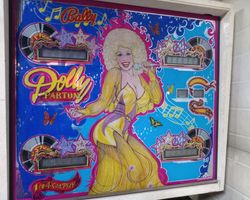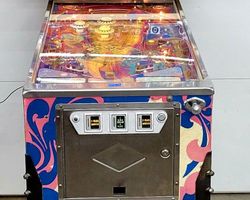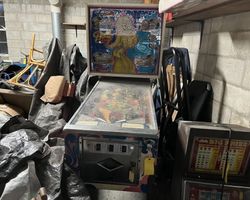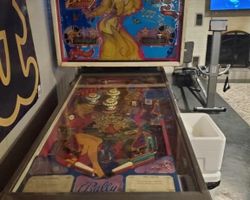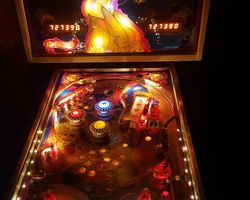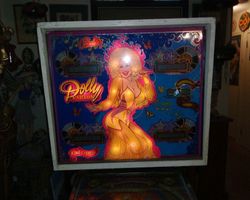Dolly Parton
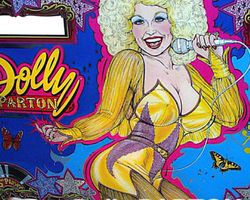
Average Prices: USD $100 to $1,600
Produced: November, 1979
Production Run: 7,350 units
Machine Type: Solid State Electronic
MPU: Bally MPU AS-2518-35
Players: 4
Design by: George Christian
Art by: Dave Christensen
When Bally Manufacturing Corporation released Dolly Parton in November 1979, the pinball world received a machine that captured a moment in popular culture while reflecting the design sensibilities of its era. This solid-state electronic game, model number 1162-E, emerged from the renowned Bally factory with a production run of 7,350 units. Its inspiration was clear: to leverage the widespread appeal of its namesake, a figure whose presence spanned both country and burgeoning pop music scenes.
The design and production of Dolly Parton involved several key contributors. George Christian was responsible for the game's layout, crafting a playfield that aimed for engaging, accessible gameplay. The visual identity of the machine, including its captivating playfield artwork, was brought to life by Dave Christensen. However, the development journey was not without its distinctive challenges. During the artistic phase, the portrayal of Dolly Parton herself became a central point of discussion. As she navigated a transition from her country roots to a more mainstream appeal, her representatives were precise about how her image should appear on the machine's backglass. This led to revisions, with an initial "country" themed backglass being reworked to reflect a more "crossover mainstream" aesthetic. Interestingly, while the backglass art underwent changes, the playfield maintained its depiction of Dolly in a denim outfit, a nod to her country origins, as it had already been finalized. Early cabinet artwork even showed a bouffant-haired Dolly playing a guitar, an image later omitted from the majority of the production run, suggesting further refinements were made to align with her evolving public image. These adaptations in the artwork underscore the intricate process of creating licensed pinball machines during a period of rapidly shifting celebrity personas.
Signature Features and Design
Dolly Parton distinguishes itself through a set of features that are characteristic of late 1970s pinball design, prioritizing straightforward objectives and satisfying shot feedback. The machine employs two flippers at the bottom of the playfield, providing the fundamental control for players to interact with the various targets. Centrally, three pop bumpers animate the upper playfield, creating erratic ball movement and high-scoring opportunities when the ball is trapped within their chaotic perimeter. Two slingshots guard the outlanes, adding to the unpredictable nature of ball deflection.
A standout element on the playfield is the set of four in-line drop targets. These targets, arranged horizontally, are central to the game's primary objective and offer a gratifying tactile and auditory experience when struck. Beyond these, seven standup targets are strategically placed, some requiring precise shots to activate. A kick-out hole adds another interactive element, capturing the ball briefly before returning it to play, often with a burst of points. A spinning target, a staple of pinball from this era, provides a continuously rotating target that racks up points rapidly when hit repeatedly. These features collectively enhance gameplay by creating multiple avenues for scoring and progression, encouraging players to explore different areas of the playfield. The immediate feedback from hitting these targets, especially the satisfying clatter of the drop targets, contributes to the overall engagement.
Playfield and Mechanics
The playfield layout of Dolly Parton is designed with a clear, direct flow, emphasizing target-shooting and bonus accumulation. At the heart of the playfield are the four in-line drop targets positioned centrally, which are instrumental for advancing in the game. Flanking these are various standup targets that require precision to hit consistently. The top of the playfield features the three pop bumpers, creating an energetic zone where the ball can careen, accumulating points. A kick-out hole is situated to the right, often a target for skilled shots, offering a brief respite and bonus points before returning the ball to action. A spinning target is placed within reach, offering a rapid way to score as it spins under repeated hits.
One particular design choice that influences gameplay is a ball rollover located in the middle-right section of the playfield. Striking this rollover scores a notable 5,000 points and, uniquely, returns the ball directly to the shooter lane. This feature allows for strategic resets and bonus opportunities, influencing the overall flow by interrupting continuous play to set up fresh plunges. The design philosophy behind this layout appears to be one of accessibility and clear objectives, making the game easy to understand for newcomers while still offering depth for those seeking to master shot accuracy.
The playfield artwork, created by Dave Christensen, is a vibrant and detailed representation of the machine’s theme. It features Dolly Parton prominently, often in a denim outfit, surrounded by various country music motifs. The colors are bright and inviting, contributing to an engaging visual experience. Lighting is integrated to highlight active targets and scoring zones, guiding the player's attention. The overall aesthetic is cohesive, blending the theme with the mechanical elements to create an immersive environment.
Gameplay Dynamics
The gameplay dynamics of Dolly Parton are built around a straightforward, yet engaging, progression and scoring system. The primary objective centers on the set of four in-line drop targets. Players aim to hit these targets sequentially to spell out "D-O-L-L-Y P-A-R-T-O-N." Completing this feat advances the bonus multiplier, a fundamental aspect of scoring in many machines of this era. This core mechanic provides a clear, achievable goal that drives player engagement.
Beyond spelling the name, the game encourages players to hit the various standup targets and the spinning target for immediate point accumulation. The pop bumpers in the upper playfield offer a high-scoring area where the ball can generate rapid points through chaotic collisions. The kick-out hole and the unique ball rollover, which returns the ball to the shooter lane, introduce strategic elements, allowing players to reset for a fresh plunge or to aim for a specific high-value shot. While the game does not feature complex modes or multi-ball sequences, its challenge lies in consistent target accuracy and managing ball control, particularly given the unpredictability of the inlane/outlane areas, which can lead to rapid drains if not navigated carefully. The scoring system rewards both direct target hits and bonus accumulation through the multiplier, encouraging players to strategize around these elements. The sound design, characteristic of early solid-state machines, complements the gameplay with the distinctive electronic chimes and simple melodies, including the integration of "Here You Come Again."
Reception and Legacy
Dolly Parton by Bally has garnered a mixed reception within the pinball community since its release. Its strengths often cited by enthusiasts include its straightforward, accessible gameplay, making it enjoyable for casual players and those new to pinball. Many appreciate the satisfying feedback from hitting the in-line drop targets and the high-scoring opportunities provided by the spinner. The playfield artwork, particularly the depiction of Dolly Parton herself, frequently receives praise for its detail and vibrancy, contributing positively to the machine’s aesthetic appeal. Some players find the game to be deceptively challenging, requiring precise flipper control to master, leading to a segment of the community considering it "underrated" for its replayability and engaging simplicity. It is often regarded as a machine that, while not overly complex, offers a solid pinball experience that can be fun for a few plays or even a more extended session.
However, the machine also faces criticism. The most common point of contention is often the backglass artwork, which some find less appealing or even uninspired compared to the playfield. From a gameplay perspective, some players describe the layout as too simple or lacking in "depth," suggesting that it doesn't offer enough varied shots or long-term objectives to sustain interest for dedicated collectors seeking more intricate rule sets. The inlane/outlane design can sometimes lead to what players perceive as unfair or quick drains, adding a layer of frustration for some. While the game provides core pinball action, its "flow" is sometimes critiqued, with certain shots feeling less connected than on other machines of the era.
Despite these differing opinions, Dolly Parton holds a place in pinball history as a notable licensed title from the late 1970s. Its production numbers indicate a significant market presence at the time, and its association with a prominent entertainment figure made it recognizable beyond core pinball circles. While it may not have introduced revolutionary mechanics, its design reflects the prevalent design philosophies of Bally at the time, particularly the focus on clear objectives and immediate feedback through features like drop targets and spinners. Its legacy is that of a solid, approachable pinball machine that, despite its simplicity and artistic controversies during development, continues to offer an enjoyable experience for those who appreciate the foundational elements of electro-mechanical and early solid-state pinball.
Sponsored Links
 Ebay Listings
Ebay Listings
 Auction Results
Auction Results
| Cost | Location | Date |
|---|---|---|
| USD $3,500 |  United States United States |
05 December, 2025 |
| USD $2,799 |  Illinois, United States Illinois, United States |
04 September, 2025 |
| USD $6,000 |  Indiana, United States Indiana, United States |
16 September, 2024 |
| EUR €1,980 |  Nordrhein-Westfalen, Germany Nordrhein-Westfalen, Germany |
05 June, 2024 |
| USD $900 |  Florida, United States Florida, United States |
26 March, 2024 |
| USD $2,250 |  Texas, United States Texas, United States |
09 June, 2023 |
| USD $669 |  United States United States |
12 January, 2023 |
| USD $2,100 |  Massachusetts, United States Massachusetts, United States |
26 December, 2022 |
| USD $500 |  United States United States |
29 November, 2022 |
| AUD $7,950 |  Queensland, Australia Queensland, Australia |
25 November, 2022 |


Private Policy · Search Website · Contact Us
As an eBay Partner, we may earn a commission from qualifying purchases made through links on this site, at no additional cost to you.
All trademarks and copyrighted materials remain property of their respective owners. All other content copyright 2007 - 2026 Pinpedia.

